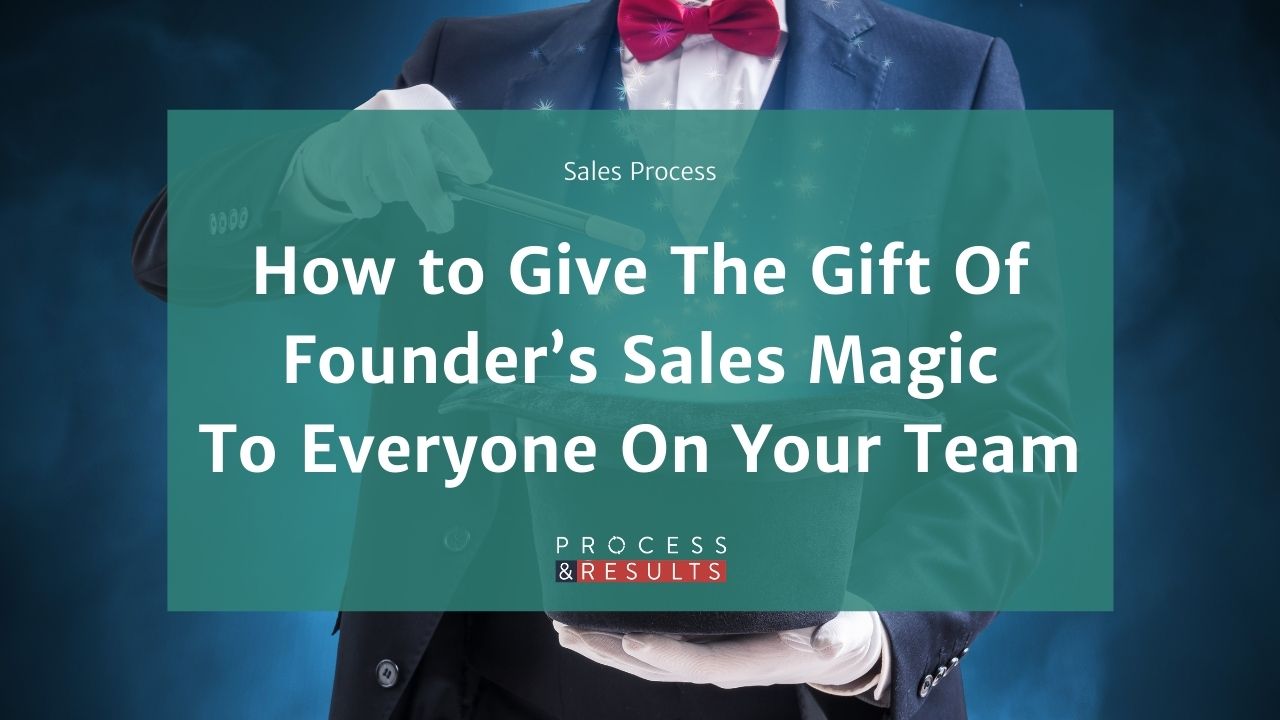
How To Give The Gift Of Founders’ Sales Magic To Everyone On Your Team
Company founders sell better than other team members. This has been the case since long before Steve Jobs got on stage to show us “one more thing.” Need proof? People want to “deal with the owner (founder)” whenever possible. It is the “VIP” treatment.
We want to believe in heroes, and someone who founded a company has been lionized as a hero in movies, books and television.
If the company president is dealing with us, we must be extraordinarily important!
This is the essence of Founder’s Magic.
Founder’s Magic is so potent that when Elizabeth Holmes pushed Theranos, people bought in even when there was nothing to sell. (There are documentaries and everything around this whole deal.)
Why Does Founder’s Magic Work?
Founder’s magic works for a few key reasons:
- The founder generally has a lot of reps- and experience builds tools.
- The founder has unshakable confidence in what they offer.
- The founder has deep knowledge of the product and owning a business.
- Founders trust other founders.
- Founders are empowered to make quick decisions without going through red tape.
Those advantages all stack to a combination that’s pretty hard to beat. Founder’s Magic is a giant advantage where even a founder that’s not skilled at sales can often out-sell their best hires.
The Issue With Relying On Founder’s Magic
There are a few issues with relying on Founder’s Magic to close deals:
- It keeps pulling the founder back into sales. This takes time that could be spent refining the sales engine they are building
- It makes a team get lazy. If someone can “just pull the founder in” to close a deal they will, and the founder shouldn’t say no. This means that they always “break the glass” and don’t build independent selling.
- It slows the company down: How many deals can a founder close? How many should they close?
- It creates entitled customers (Karens): When the customer was brought in by the founders they often don’t treat support well. They complain to the owner. They have a sense of entitlement that makes it difficult to serve them. They will “go over their head to the owner.”
How To Give Your Entire Team a Little Founder’s Magic
So we want our team to sell like a founder without bringing in the founders to babysit every deal. That’s reasonable.
There are three things needed to make this happen:
#1. Have Rules Of Engagement
Founders should only handle the biggest and most important deals. Build out rules of engagement in advance so the entire team knows which deals qualify.
- Have a deal-size threshold: unless the deal is going to be 4% of your gross revenue or more, your founders should sit out and let the team get that handled.
- Have a Rule That Always Brings In The Founder: Any time a deal is potentially big (5% of revenue or 25% of quarterly target) you should have the founders get involved.
- Have a phase when the founders get involved & get an agreement in principle (and get out). We want the founders to be engaged to welcome their customers and clients and make the team feel like they are “under our protection” and then we want them to leave.
With a few simple rules (deal size, amount of involvement), you will bring the founders in only when necessary.
#2. Give Your People Freedom To Cut Red Tape (And Wisdom To Know When To Say No)
Every time the founder gets involved, we should try to make decisions based on general rules. If exceptions are made during a deal, founders should report to the team:
- Why they made the choice to extend an exception.
- What we think this will cost the company.
- What would have made this into a bad deal.
This way the team gets to understand the thought process behind why a deal is good or bad.
An example would be this:
This will help all of your founders transfer the “why” behind when a deal works or doesn’t work.
#3: Have an onboarding process that feels like a party.
It’s fun to invite people to a party. Way more fun than setting something up.
So when we onboard our customers, it should feel like a party.
We’ll dig more into this soon, but the ideas here are:
Here’s what we’re doing now:
- Ask a quick set of fun questions & get their mailing address for now (At the time of this writing we’re in PandemicVille).
- Send a QuickPage intro video (or Bomb-Bomb if you’re old school) from the founder and team.
- Send a quick bit of initial work that’s been done and schedule time with the success reps.
- Send a series of postcards via Thanks.IO that cover our ideas.
- Have a plan to keep the celebration going.
Like this post? Get A New Business Process Every Monday
Join our newsletter, and we'll send you a new business process every Monday.
We cover everything that service businesses need to improve.
